Covering over 1000 sq. Km, Nyungwe forest is one of the world’s most beautiful and pristine mountain rain-forests also believed to be one of the oldest.

Nyungwe forest is ever green even through the Ice Age, which explains its diversity. The park is home to habituated chimpanzees and 12 other primate species (including a 400-strong troop of habituated Ruwenzori Black & White Collobus). It’s also a birder’s paradise with over 300 species, including 16 endemics, and is home to 75 different species of mammal.
This majestic rainforest is filled with nature and wildlife experiences for you to emerge yourself in. Hiking or even biking the beautiful terrain, tracking the famous chimpanzees, experiencing the canopy walk, witnessing beautiful birds, relaxing by waterfalls are just a glimpse of activities that Nyungwe offers.
Sounds and views collaborate to create a one-of-a-kind wildlife experience. Exploring through the forest, travelers will witness the lush green mountains and cooling mist in a landscape that won’t be soon forgotten. Cultural activities are also available around the forest.
WHAT TO DO IN NYUNGWE FOREST PARK
Chimpanzee tracking
The home of roughly 400 species of chimpanzees, Nyungwe is home to one of East Africa’s last intact populations and boasts two wild chimp communities that welcome guests (one in Cyamdungo and other around Uwinka). Thus, it’s not surprising that chimpanzee tracking is a popular activity in Nyungwe (especially when the park’s trees are in full bloom during the summer) as well-trained guides often lead visitors through the park’s forests. And while actually viewing chimpanzees is not guaranteed, you’ll enjoy learning about these creatures and their natural habitats from your guides. But you’ll probably have to get up around four a.m. to succeed in this very challenging activity as chimps are mostly likely to be seen early in the morning.
Canopy Walkway
Visitors to Nyungwe National Park can experience the rainforest from a new perspective: the Canopy Walkway. Hanging 60 meters above the forest floor between giant trees and towers, East Africa’s only Canopy Walkway provides a stunning view of the park’s amazing wildlife and nature. The Walkway is accessible as part of a specialized guided tour along the Igishigishigi trail or if you’re not part of a tour, hiking the Imbaraga or Umuyove trails.
Conducted year-round, the Canopy Walkway Tour costs $60 U.S. per person. All participants must be at least six years of age and children must be accompanied by adults. You should bring a raincoast as rain frequently falls in Nyungwe. But if you don’t come with a raincoat, you can rent one as well as walking boots and sticks.
Nature trails
Visitors to Nyungwe National Park can experience the rainforest from a new perspective: the Canopy Walkway. Hanging 60 meters above the forest floor between giant trees and towers, East Africa’s only Canopy Walkway provides a stunning view of the park’s amazing wildlife and nature. The Walkway is accessible as part of a specialized guided tour along the Igishigishigi trail or if you’re not part of a tour, hiking the Imbaraga or Umuyove trails.
Conducted year-round, the Canopy Walkway Tour costs $60 U.S. per person. All participants must be at least six years of age and children must be accompanied by adults. You should bring a raincoast as rain frequently falls in Nyungwe. But if you don’t come with a raincoat, you can rent one as well as walking boots and sticks.
Community based tourism
As wonderful as exploring the diverse ecosystem of the Nyungwe National Park is, you really won’t get a feel for the area until you discover its rich culture. The region’s song, dance, music and cuisine are all integral parts of Nyungwe’s culture and walking tours of Banda Village – located 15 km down the mountain from the Uwinka Visitors Centre – represent the perfect setting for learning about an area where people have lived for more than 50,000 years. The tours provide guests the opportunity to participate in activities such as local food tasting and basket weaving and if you’re fortunate, you might able to attend a traditional wedding ceremony and learn about traditional medicine.
WHAT TO SEE IN NYUNGWE FOREST PARK
Primates
Chimpanzees are far from the only creature that will fascinate wildlife lovers in Nyungwe as with thirteen recorded species, the park is home to East Africa’s most diverse primate population. Nyungwe is the only location in Africa where you’ll find “supergroups” of more than 300 Colobus monkeys and one of the few places worldwide where you’ll see L’Hoest’s monkeys (primarily on the main round near Uwinka). Another rare animal you might also run into is the owl-faced monkey, an Albertine Rift endemic that inhabits Nyungwe’s southern forests. In fact, most of the monkey species found in the park are endemic.
Birds
Described by Birdlife International as “the most important site for biodiversity conservation in Rwanda,” the Nyungwe National Park is home to roughly 310 bird species, 27 of which are endemic to the Albertine Rift. Although actually spotting birds in the park’s forests may be challenging, the bird songs you’ll hear during the trek will surely make it more enjoyable. If you would like to learn about birds you might see and hear, book a guide for $50 U.S. at the headquarters of the Rwanda Development Board. The guides so knowledgeable about birdlife in Nyungwe they can identify birds by ear, such as the rwenzori turaco and grey-chested kakamega.
Culture
As wonderful as exploring the diverse ecosystem of the Nyungwe National Park is, you really won’t get a feel for the area until you discover its rich culture. The region’s song, dance, music and cuisine are all integral parts of Nyungwe’s culture and walking tours of Banda Village – located 15 km down the mountain from the Uwinka Visitors Centre – represent the perfect setting for learning about an area where people have lived for more than 50,000 years. The tours provide guests the opportunity to participate in activities such as local food tasting and basket weaving and if you’re fortunate, you might able to attend a traditional wedding ceremony and learn about traditional medicine.
Conservation
The Wildlife Conservation Society (WCS) has collaborated throughout the years with local communities and leaders to find ways of conserving the beauty of Nyungwe through tourism development, awareness campaigns and policy development. In large part because of the hard work of many parties, Nyungwe was designated Rwanda’s third national park. The WCS and its partners have since created a network of moderate hiking trails, a canopy walkway and the region’s first interpretation center. The Rwandan government has also expressed its commitment to preservation by developing a park management plan with WCS that regulaties zoning for conservation, tourism and sustainable harvesting.
Vegetation
Home of the largest block of montane forest in East Africa, the Nyungwe National Park boasts more than 200 different types of trees and 140 species of orchids (including eight that are endemic). The park contains numerous medicinal plants that have served as remedies for centuries, such as East African satinwood and California Bayberry.

